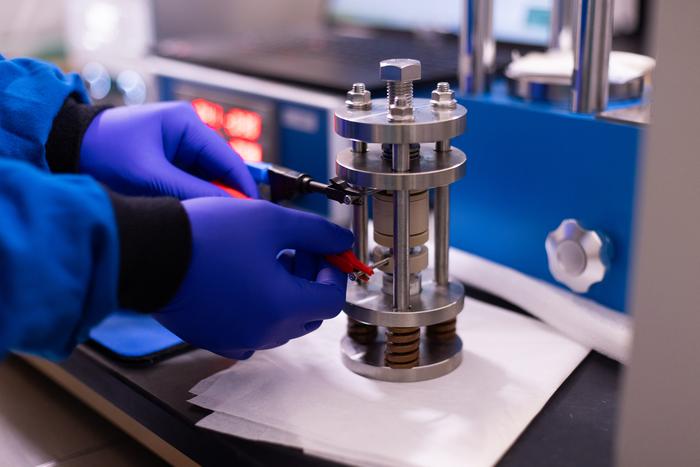An innovative leap in lithium-ion battery technology has emerged from a collaborative research effort at the University of Texas at Dallas. The research team has uncovered a groundbreaking phenomenon that could significantly enhance the efficiency of solid-state batteries, which are pivotal for the future of mobile devices and electric vehicles. This discovery, revolving around the mixing of small particles between two solid electrolytes, marks a critical advancement in the pursuit of safer and more powerful energy solutions.
Traditional lithium-ion batteries predominantly rely on liquid electrolytes, which are known for their flammability, raising safety concerns. As conventional battery technology nears its energy storage limits, researchers have turned their gaze toward solid electrolytes, which promise to double the energy capacity and improve safety. However, one key challenge exists: the movement of ions through solid materials proves to be considerably harder than in liquid systems. This is where the newly discovered “space charge layer” phenomenon presents a potential solution.
Dr. Laisuo Su, a co-corresponding author of the study and an assistant professor in the materials science and engineering department, elaborates on the essence of the research. The space charge layer forms at the interface between two solid electrolyte materials when they physically contact. It is a unique accumulation of electric charge that becomes evident due to variances in chemical potential in each material. The existence of this layer creates pathways akin to channels, facilitating the easier movement of ions across the interface, which is critical to battery performance.
The idea can be likened to a culinary recipe where two ingredients blend to produce an unexpectedly superior dish. In this case, the combination of specific solid electrolytes—lithium zirconium chloride and lithium yttrium chloride—results in enhanced ionic activity that surpasses what either material could offer independently. This revelation opens the door to a new paradigm in solid electrolyte design, emphasizing material interactions that maximize ionic mobility.
This research aligns with the overarching goals of UTD’s BEACONS initiative, which aims to spearhead advancements in battery technology with substantial backing from the Department of Defense. Launched in 2023 with a significant investment of $30 million, BEACONS focuses on the development and commercialization of next-gen battery technologies, ensuring greater availability of critical materials, and training high-caliber professionals in the industry. Solid-state battery technologies represent the forefront of these next-generation chemistries.
In the context of defense applications, solid-state batteries could revolutionize drone technology by enhancing performance and reliability. Dr. Kyeongjae Cho, director of BEACONS, emphasizes the operational advantages this new technology could bring to military capabilities. The department is excited about the implications of solid-state batteries not just for civilian applications but also for strategic defense operations.
In a world increasingly dependent on batteries for everything from smartphones to electric vehicles, the significance of developing robust, safe battery technologies cannot be overstated. As researchers push the frontier of materials science, understanding how to manipulate interfaces between solid electrolytes will be indispensable in pushing the performance limits. The study has put forth a foundational theory explaining how the mixing of these electrolytes can lead to the construction of unique ion transport channels—critical for high-performance battery systems.
Moving forward, the research team plans to delve deeper into the intricacies of how electrolyte composition and interface structure affect ionic conductivity. These investigations will be crucial for refining the design of solid-state batteries that can sustain higher energy levels while maintaining safety standards. Dr. Boyu Wang, the first author of the study, is optimistic that continued research will yield insights that further propel advancements in battery technology.
This research is vital not only for consumer electronics but also for the broader transition to clean energy. As electric vehicles gain popularity, the need for efficient and safe battery technology intensifies. Solid-state batteries could play a central role in this transition, alleviating concerns associated with current lithium-ion technologies. Researchers are hopeful that their findings will inspire a wave of innovation, prompting other scientists and engineers to explore this fertile ground further.
The collaboration also highlights the importance of multidisciplinary approaches in scientific research. The involvement of researchers from Texas Tech University alongside UTD’s experts facilitated a richer exchange of ideas and technical know-how. This joint effort underscores the notion that complex scientific challenges often require collaborative solutions, blending diverse expertise from multiple institutions to drive progress.
In conclusion, the findings from this research signify a critical step toward realizing the full potential of solid-state batteries. By unlocking the secrets of ion movement between solid electrolytes, the researchers have opened new pathways for innovation in battery technology. The journey toward safer, more efficient energy storage solutions is one that continues to evolve, driven by such pioneering studies.
Subject of Research: Discovery of space charge layer in solid electrolytes
Article Title: 1 +1 > 2 Effect Induced by Space Charge in Solid Electrolytes
News Publication Date: 14-Feb-2025
Web References: https://pubs.acs.org/doi/epdf/10.1021/acsenergylett.4c03398
References: 10.1021/acsenergylett.4c03398
Image Credits: The University of Texas at Dallas
Keywords
Battery Technology, Solid-state batteries, Electrolytes, Lithium-ion batteries, Energy Storage, Materials Science.




